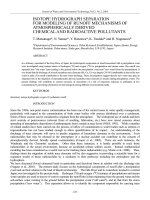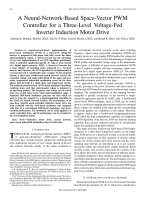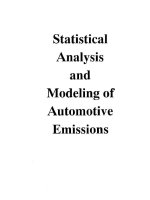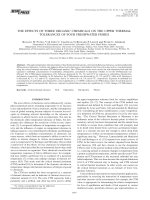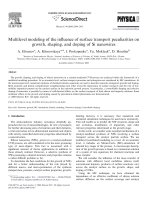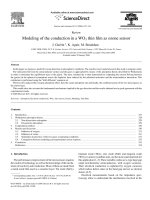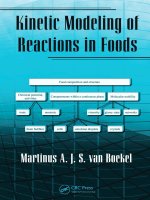Modeling of three winding voltage regulating transformers
Bạn đang xem bản rút gọn của tài liệu. Xem và tải ngay bản đầy đủ của tài liệu tại đây (194.04 KB, 11 trang )
SIEMENS
Siemens Energy, Inc.
Power Technology
Issue 106
Modeling of Three-Winding Voltage Regulating Transformers for
Positive Sequence Load Flow Analysis in PSS®E
Carlos Grande-Moran, Ph.D.
Principal Consultant
Introduction
Multi-winding power transformers and autotransformers are important components in
transmission and distribution power systems. They make possible the transfer of energy between
networks operating at various voltage levels, the interconnection of multiple shaft combined cycle
generating units to a power grid and the connection of reactive compensation resources to EHV
transmission networks, just to name a few applications. The modeling of these power system components
in the steady state analysis of electrical networks is critical since incorrect data for their positive sequence
winding leakage impedance, magnetizing admittance, off-nominal turn ratios, number of tap positions, tap
range or voltage control band may lead to erroneous results in the verification of voltage and reactive
power control schemes, and in the assessment of transmission losses and system reliability.
The main objective of this article is to assist PSS®E users with a guide for entering electrical transformer
data for the positive sequence model of the electrical network with a minimum of effort and minimizing the
potential for errors.
Notes and suggestions for entering each of the required model variables are given below, along with an
example demonstrating the entry of the data for a three-winding voltage regulating transformer.
Model Data Requirements
The positive sequence network model used by PSS®E for three-phase three-winding transformers or
autotransformers or three-phase banks of three identical single-phase three-winding transformers is
shown in Figure 1 below. The model includes the three equivalent leakage impedances of the windings,
Z1= r1 +j x1, Z2 = r2 +j x2 and Z3 = r3 +j x3, and allows off-nominal taps to be represented on each of the
windings. This model also allows the modeling of the transformer magnetizing admittance, Ym = Gh+e - j
Bm, that is often neglected on the I-side (winding 1) of the transformer. One of the many features found in
PSS®E is that the user does not have to calculate the between-windings leakage impedances,
magnetizing admittance, effective off-nominal transformer taps, tap steps or tap limits; these calculations
are performed within PSS®E.
Power Technology
July 2010
Figure 1 - PSS®E Three-Winding Transformer Model
The “star” or “T” network equivalent model shown in Figure 1 for three-winding transformers and threewinding autotransformers includes the equivalent leakage impedances Z1, Z2 and Z3 in per unit on a
common three-phase apparent power base and phase-to-phase winding base voltages VWB1, VWB2
and VWB3. Simple linear relationships exist between the equivalent leakage impedances Z1, Z2 and Z3
and the between-windings leakage impedances Z1-2, Z2-3 and Z3-1 that are generally supplied on a
transformer data sheet or test report. These are:
Z1-2 = Z1 + Z2 (Ohm or pu)
Z2-3 = Z2 + Z3 (Ohm or pu)
(Eqs. 1)
Z3-1 = Z3 + Z1 (Ohm or pu)
and
Z1 = (1/2)*[ Z1-2 + Z3-1 – Z2-3] (Ohm or pu)
Z2 = (1/2)*[ Z1-2 + Z2-3 – Z3-1] (Ohm or pu)
(Eqs. 2)
Z3 = (1/2)*[ Z2-3 + Z3-1 – Z1-2] (Ohm or pu)
Note that the between-windings leakage impedances Z1-2, Z2-3 and Z3-1 are complex number quantities
(resistance and reactance) obtained from the following short circuit tests:
1. Z1-2 = r1-2 +j x1-2, obtained from a test where winding 2 is shorted, winding 1 is excited with a
voltage such that rated current flows through the short circuit in winding 2 and winding 3 is left with
its terminals open.
2. Z2-3 = r2-3 +j x2-3, obtained from a test where winding 3 is shorted, winding 2 is excited with a
voltage such that rated current flows through the short circuit in winding 3 and winding 1 is left with
its terminals open.
3. Z3-1 = r3-1 +j x3-1, obtained from a test where winding 1 is shorted, winding 3 is excited with a
voltage such that rated current flows through the short circuit in winding 1 and winding 2 is left with
its terminals open.
Page 2
Power Technology
July 2010
PSS®E models three-winding transformers internally as three two-winding transformers connected
together at a common “star point” bus. This star point bus is handled internally to PSS®E and is not visible
to the user. The windings selected as winding 1 in each of these three two-winding transformers are
connected to buses “I,” “J” and “K,” respectively, as shown in Figure 1. The model has the capability of
under-load tap adjustment in all three windings. The ideal transformers used in the “star” network
equivalent model have the off-nominal taps t1, t2 and t3 associated with their winding 1. Winding 2 always
has a nominal tap (i.e., 1.0 per unit) in these transformers.
As users create their transformer data records, PSS®E’s flexibility becomes apparent. Each of the
required model variables is discussed below:
Between-windings leakage impedances (Z1-2, Z2-3 and Z3-1) can be specified in three ways:
in per unit on a system three-phase apparent power base (SBASE, usually 100 MVA) and
windings 1, 2 and 3 phase-to-phase rated voltages for fixed tap transformers, and nominal tap
for transformers fitted with either under-load or off-load taps (t10 = t20 = t30= 1.0 per unit on
winding voltage base or t10 =VWB1 kV, t20 = VWB2 kV and t30= VWB3 kV) – Impedance code
CZ=1.
in per unit on winding base (usually the ONAN rating), using winding 1-2 three-phase
apparent power base (SB1-2),winding 2-3 three-phase apparent power base (SB2-3), and
winding 3-1 three-phase apparent power base (SB3-1), and windings 1, 2 and 3 phase-tophase rated voltages (VWB1, VWB2 and VWB3) for fixed tap transformers and nominal tap
for transformers fitted with either under-load or off-load taps (t10 = t20 = t30 = 1.0 per unit on
winding voltage base or t10 = VWB1 kV, t20 = VWB2 kV and t30 = VWB3 kV) – Impedance
code CZ=2.
entering the short circuit test three-phase full-load winding copper losses between windings 12, 2-3 and 3-1 (Wsc1-2, Wsc2-3, and Wsc3-1) in Watts and the winding impedance voltage
magnitude or between windings leakage impedance magnitude |Z1-2|, |Z2-3| and |Z3-1|.
These impedances are expressed in per unit on windings 1-2 (SB1-2), windings 2-3 (SB2-3),
and windings 3-1 (SB3-1) three-phase apparent power base, (usually the ONAN rating), and
phase-to-phase winding rated voltages (VWB1, VWB2 and VWB3) for fixed tap transformers,
and nominal tap for transformers fitted with either under-load or off-load taps (t10 = t20 = t30 =
1.0 per unit on winding voltage base or t10 = VWB1 kV, t20 = VWB2 kV and t30 = VWB3 kV) –
Impedance code CZ=3.
Transformer magnetizing admittance (Ym) can be specified in two ways:
in per unit on a system three-phase apparent power base (SBASE, usually 100 MVA), and
winding 1 phase-to-phase bus voltage base – Magnetizing Admittance code CM=1.
entering the open circuit test three-phase no-load core losses (Wnl) in Watts and the no-load
excitation current magnitude or the magnetizing admittance magnitude in per unit on the
winding 1-2 three-phase apparent power base (SB1-2) and winding 1 phase-to-phase rated
voltage (VWB1) for fixed tap transformers and nominal tap for transformers fitted with either
under-load or off-load taps (t10 = 1.0 per unit on winding voltage base or t10 = VWB1 kV) –
Magnetizing Admittance code CM=2.
Windings 1-2, 2-3 and 3-1 three-phase apparent power MVA (SB1-2, SB2-3 and SB3-1):
This is the three-phase apparent power MVA used in the normalization (per unit representation)
of the between-windings leakage impedances Z1-2, Z2-3 and Z3-1. Use of the transformer’s
three-phase winding nameplate rating, which is usually the ONAN rating, is strongly
recommended. However, any other three-phase apparent power base can be used. System bus
voltage base refers to the bus phase-to-phase voltage base kV of the buses to which the
terminals of the three-winding transformer are connected. Note that when specifying base
quantities for three-winding transformers, you must specify three apparent power base quantities
Page 3
Power Technology
July 2010
and three winding voltage base values, one for winding 1 (NOMV1), one for winding 2 (NOMV2)
and another for winding 3 (NOMV3).
Winding nominal voltage (NOMV1, NOMV2, NOMV3):
A nominal phase-to-phase voltage, usually the phase-to-phase rated winding voltage or nominal
tap winding voltage, should be entered for winding 1, winding 2 and winding 3. The nominal
voltage for winding 1 is used in the computation of the per unit transformer magnetizing
admittance on a system three-phase apparent power MVA and system bus voltage base. The
nominal voltage for windings 2 and 3 are used to convert the per unit tap values on a winding
voltage base to per unit tap values on system bus voltage base (PSS®E version 31 and 32). The
default value for these three data entry points is 0.0 kV, which is interpreted by PSS®E to mean
that the winding nominal voltage is equal to the voltage base of the bus to which the transformer
is connected. For PSS®E versions 30 and earlier, the nominal voltages for windings 2 and 3 are
not used in any calculations related to the between-windings leakage impedances, per unit tap
values, or performance of a transformer unit.
Number of tap positions in windings 1, 2 and 3 (NTP1, NTP2 and NTP3):
PSS®E assumes that the nominal tap position is midway in the tap range - (NTP1+1)/2,
(NTP2+1)/2 and (NTP3+1)/2. PSS®E also assumes that the winding tap step is constant: Δt1=
TSTEP1= (Rmax1 – Rmin1)/(NTP1-1), Δt2= TSTEP2= (Rmax2 – Rmin2)/(NTP2-1), and Δt3=
TSTEP3= (Rmax3 – Rmin3)/(NTP3-1).
Winding off-nominal taps (WINDV1, WINDV2, WINDV3):
Automatic adjustable taps (ULTC or OLTC) can be associated with winding 1 (t1), winding 2 (t2)
and/or winding 3 (t3). These taps may be specified in three ways:
in per unit on bus “I”, “J” and “K” phase-to-phase bus voltages – Winding code CW=1.
in kV on winding 1, 2 and 3 phase-to-phase voltages (NOMV1, NOMV2, NOMV3) – Winding
code CW=2.
in per unit on winding 1, 2 and 3 phase-to-phase rated or nominal voltages – Winding code
CW=3.
Tap limits (Rmax1, Rmax2, Rmax3, Rmin1, Rmin2, Rmin3):
These parameters apply to the taps in windings 1, 2 and 3 and they define the winding tap range.
Maximum and minimum tap values are used for these limits: Rmax1, Rmax2, and Rmax3 for the
upper limits and Rmin1, Rmin2, and Rmin3 for the lower limits. These tap limits may be specified
in three ways:
in per unit on bus “I,” “J” and “K” phase-to-phase bus base voltages – Winding code CW=1.
in kV on winding 1, 2 and 3 phase-to-phase voltages – Winding code CW=2.
in per unit on winding 1, 2 and 3 phase-to-phase nominal voltages (NOMV1, NOMV2,
NOMV3) – Winding code CW=3.
Winding 1, winding 2 and winding 3 voltage phase shift angle (Θ1, Θ2 and Θ3):
The relative phase angle between winding 1 and winding 2 for each of the three two-winding
transformers used in the modeling of three-winding transformers may be specified in the
transformer data record. This phase shift angle is measured in electrical degrees and is assumed
to be positive when the phase voltage at each of the three W1 windings leads the phase voltage
Page 4
Power Technology
July 2010
at the “star point” bus. For example, for the transformer connection YNynd5 (using IEC notation),
the angle Θ1= 0°, Θ2= 0° and Θ3= -150°.
Transformer control band (Vmax, Vmin):
The upper and lower limits of voltage control band for regulating transformers, one for each
winding, are specified in the entries Vmax and Vmin, respectively. The value for these limits may
be expressed in either kV or per unit on bus voltage base when the transformer control mode is 1
(i.e., voltage control) or in Mvar flow into the terminals of windings 1, 2 or 3 when the transformer
control mode is 2 (i.e., reactive power flow control). When the upper and lower voltage limits are
expressed in per unit, the voltage base is the bus base voltage of the controlled bus, that is the
bus where local or remote voltage control is desired. It is important to keep in mind that the
control band width (Vmax – Vmin) must be large enough to ensure that there is a tap position that
will result in operation within that voltage band. For example, if the control band width is equal to
or greater than two times the transformer’s tap step TSTEP, this will guarantee that when the tap
adjustment option is used in a load flow solution (and the transformer control mode is 1), the load
flow solution will not oscillate between tap limits and, assuming that a limit is not reached, that the
solution will find a tap position that results in operation within that voltage band. When the control
mode is 1, the default values are: 1.1 per unit for the control band upper limit (or 1.1*bus voltage
base in kV) and 0.9 per unit for the control band lower limit (or 0.9*bus voltage base in kV). There
are no default values allowed for control mode 2. Each winding can exert control on voltage,
active power or reactive power on a selected local or remote bus.
Transformer control mode (COD1):
Voltage regulating transformers in PSS®E can be modeled in three control modes:
mode 0, the default mode, where taps in both windings are set manually and are fixed (not
adjusted by the load flow solution)
mode 1, voltage control mode, where windings 1, 2 and 3 taps are adjusted when the load
flow solution option “tap adjustment” is selected
mode 2, Mvar control mode, where windings 1, 2 and 3 taps are adjusted when the load flow
solution option “tap adjustment” is selected
Each winding has an independent control mode function in PSS®E.
Important Notes:
It is important to note that the transformer model in PSS®E automatically adjusts the between-windings
leakage impedance when there is a mismatch between the winding voltage base (NOMV1, NOMV2 and
NOMV3) and the bus base voltage where these terminals are connected. For example, if the winding 1
voltage base (NOMV1) is not the same as its bus base voltage, PSS®E will adjust the transformer winding
leakage impedance using the winding 1 turns ratio t1. Similar adjustment will be made to the other winding
turns ratios, t2 and t3, if the other two windings’ base voltages do not match their respective bus base
voltages.
When specifying data in per unit (winding code CW=1), these off-nominal winding turn ratios, t1, t2 and t3,
are specified by the user as:
t1 = (winding 1 voltage base NOMV1 / bus “I” base voltage), when specifying data in per
unit (winding code CW=1)
= winding 1 voltage base NOMV1when given in kV (winding code CW=2)
Page 5
Power Technology
July 2010
t2 = (winding 2 voltage base NOMV2 / bus “J” base voltage), when specifying data in per
unit (winding code CW=1)
= winding 2 voltage base NOMV2 when given in kV (winding code CW=2)
t3 = (winding 3 voltage base NOMV3 / bus “K” base voltage), when specifying data in per
unit (winding code CW=1)
= winding 3 voltage base NOMV3 when given in kV (winding code CW=2)
When the winding code CW is 3, taps are specified in per unit on a winding voltage base and PSS®E will
automatically take care of the voltage base mismatch by multiplying the winding off-nominal tap by the
factor (winding base voltage/bus base voltage).
The winding tap limits Rmax1, Rmax2, Rmax3, Rmin1, Rmin2, and Rmin3 must also be adjusted when
they are specified in per unit on bus base voltage (winding code CW=1).
Note that all computations carried out by PSS®E are performed in per unit on a system three-phase
apparent power base and phase-to-phase bus voltage base. Also, it is important to note that the selection
as to which winding will be called winding 1, winding 2 or winding 3 is arbitrary. But once the selection is
made, the user must be consistent in applying the appropriate index to all parameters associated with
each winding.
Legacy data for three-winding transformers (entered using the data formats available in all versions of
PSS®E up to and including version 26) was limited to (1) using three two-winding transformers, (2) an
explicit “star point” node modeled as a bus and (3) equivalent leakage impedances Z1, Z2 and Z3
specified in per unit on a three-phase apparent power system base and bus base voltage. These legacy
three-winding transformers can continue to be used, or they can be removed and re-entered using the
formats described above. Care should be taken in converting to the new format that the proper bases are
used.
Numerical Example
A numerical example follows to show how a three-winding transformer is modeled and how the model
data is entered into PSS®E.
For our example we will use a three-winding, three-phase autotransformer unit with the following
characteristics:
nominal phase-to-phase winding voltages of 135.4 kV, 69.5 kV and 47.3 kV
OA/FA/FA three-phase apparent power ratings of 30/40/50 MVA for the HV and MV windings
24/32/40 MVA for the LV (tertiary) winding
33 under-load taps (±16 steps + neutral position) on the HV winding with a tap step of 0.625%
a nominal operating frequency of 60 Hz
high and medium voltage (HV, MV) circuits connected wye solidly grounded
low voltage (LV) windings connected delta
The transformer unit has the following transformer test report data:
Short Circuit Test
1. Three-phase load losses at 75°C between HV and MV circuits of 64,360 W.
2. Three-phase load losses at 75°C between HV and LV circuits of 90,960 W.
3. Three-phase load losses at 75°C between MV and LV circuits of 107,060 W.
Page 6
Power Technology
July 2010
4. Impedance voltage or winding leakage impedance magnitude between HV and MV circuits of 3.74%
on a 30 MVA three-phase apparent power base, 135.4 kV/69.5 kV voltage base and 75°C.
5. Impedance voltage or winding leakage impedance magnitude between HV and LV circuits of
11.66% on a 24 MVA three-phase apparent power base, 135.4 kV/47.3 kV voltage base and 75°C.
6. Impedance voltage or winding leakage impedance magnitude between MV and LV circuits of 8.18%
on a 24 MVA three-phase apparent power base, 69.5 kV/47.3 kV voltage base and 75°C.
No-load or Open Circuit Test:
1. Three-phase no-load (core) losses at 100% voltage (1.0 per unit or nominal) of 34,380 W.
2. Excitation current RMS magnitude of 0.29% (0.0029 per unit) at 100% voltage (135.4/√3 kV) and 30
MVA three-phase apparent power base.
This three-phase, three-winding autotransformer unit will be used in a sub-transmission substation to
deliver energy from a 138 kV HV bus bar to circuits operating at nominal voltages of 69 kV and 46 kV.
Based on the transformer nameplate data and the short-circuit and no-load test data the following is
known:
1.
2.
3.
4.
5.
6.
7.
8.
9.
10.
11.
12.
HV bus base voltage: 138.0 kV
MV bus base voltage: 69.0 kV
LV bus base voltage: 46.0 kV
HV winding voltage base (model’s winding 1): 135.4 kV
MV winding voltage base (model’s winding 2): 69.5 kV
LV winding voltage base (model’s winding 3): 47.3 kV
Number of taps: 33
Tap range, Rmax1 = 1.10 per unit (148.94 kV) and Rmin1 = 0.90 per unit (121.86 kV) on a 135.4 kV
voltage base
Between Circuits (windings for conventional three-winding transformers) 1 and 2 three-phase MVA
base (SB1-2): 30 MVA
Between Circuits (windings for conventional three-winding transformers) 3 and 1 winding threephase MVA base (SB3-1): 24 MVA
Between Circuits (windings for conventional three-winding transformers) 2 and 3 winding threephase MVA base (SB2-3): 24 MVA
System three-phase MVA base (SBASE): 100 MVA
Since the short-circuit and the no-load test data are available, the recommended approach for entering
the transformer data in PSS®E is:
1. Impedance code CZ=3, load losses and per unit impedance voltage (per unit leakage impedance
magnitude)
2. Magnetization admittance code CM=2, no-load losses and per unit excitation current
3. Winding code CW=1, taps in per unit on a bus voltage base
4. Control mode: None if the transformer is equipped with off-load taps or Voltage if the transformer is
equipped with an under-load tap changer.
The four data entry codes above define the data entry format and thus must be selected before the
correct values to enter can be determined. Using the codes recommended above, the process described
below is used.
Given that tap values for circuits 1, 2 and 3 will be entered in per unit on a bus voltage base (CW=1), the
tap value t1 and upper and lower tap limit, Rmax1 and Rmin1, will be specified as:
t1 = 135.4/138 = 0.98116 per unit (assuming that the transformer tap is set at its neutral position,
i.e., at nominal tap)
Rmax1 = (1.10*135.4)/138 = 1.07928 per unit on a 138 kV base
Rmin1 = (0.90*135.4)/138 = 0.88304 per unit on a 138 kV base
Page 7
Power Technology
July 2010
Winding 2 and winding 3 will have the following tap data because their winding rated voltages do not
match their bus base voltages:
t2 = 69.5 kV/69.0 kV = 1.00725 per unit on a 69.0 kV base
t3 = 47.3 kV/46.0 kV = 1.02826 per unit on a 46.0 kV base
Note that 1.0 per unit voltage on a 69.5 kV base (winding voltage base) is equivalent to 1.00725 per unit
on a 69.0 kV system voltage base. In general, whenever there is a mismatch between the winding voltage
base and the bus base voltage and the winding code is CW=1, taps expressed in per unit on bus voltage
base must be entered using the expression:
t1, t2 or t3 = (winding 1, winding 2 or winding 3 nominal voltage)/ bus base voltage
The parameters Rmax2, Rmax3, Rmin2 and Rmin3 are left undisturbed at their default values since these
windings do not have taps; if they did have taps, the user must also modify these parameters using the
following expressions:
Rmaxi = (kVi,max / Vbus,i base)
Rmini = (kVi,min / Vbus,i base)
i = 2, 3
If a user selects the winding code CW=2, the values for taps t1, t2, t3 and tap range Rmax1 and Rmin1
would be:
t1 = 135.4 kV (nominal tap position)
t2 = 69.5 kV
t3 = 47.3 kV
Rmax1 = 148.94 kV
Rmin1 = 121.86 kV
In PSS®E version 31, the new winding code 3 (CW=3) was introduced. If a user selects the winding code
to be (CW=3), and winding 1 is the 134.5 kV winding, winding 2 is the 69.5 kV winding and winding 3 is
the 47.3 kV winding, then the values for taps t1, t2, and t3, and tap range Rmax1 and Rmin1 would be:
t1 = 1.0 per unit (assuming the tap is set at its neutral position, i.e., nominal tap)
t2 = 1.0 per unit (on a 69.5 kV winding voltage base)
t3 = 1.0 per unit (on a 47.3 kV winding voltage base)
Rmax1 = 1.10 per unit on a 135.4 kV base
Rmin1 = 0.90 per unit on a 135.4 kV base
The data record for the transformer unit for CW=1, CZ=3 and CM=2 is:
Page 8
Power Technology
July 2010
CASE 1
GENERAL DATA
X- XFRMER -X X---- WINDING 1 BUS ----X X---- WINDING 2 BUS ----X X---- WINDING 3 BUS ----X
S C C C
X-- NAME --X
BUS# X-- NAME --X BASKV
BUS# X-- NAME --X BASKV
BUS# X-- NAME --X BASKV CKT T W Z M OWN1 FRAC1 OWN2 FRAC2 OWN3 FRAC3 OWN4 FRAC4
1 HV
138.00
2 MV
69.000
3 LV
46.000 1 1 1 3 2
1 1.000
IMPEDANCE DATA
X- XFRMER -X S C X--------- SPECIFIED NOMINAL MEASURED IMPEDANCES AND MVA BASES ----------X X-ACTUAL IMPEDANCES FROM IMPEDANCE CORRECTION TABLE-X
X-- NAME --X T Z
R 1-2
X 1-2 SBAS1-2
R 2-3
X 2-3 SBAS2-3
R 3-1
X 3-1 SBAS3-1
R 1-2
X 1-2
R 2-3
X 2-3
R 3-1
X 3-1
1 3
64360 0.03740
30.0
107060 0.08180
24.0
90960 0.11660
24.0
X- XFRMER -X X----- WINDING BUS -----X
X-- NAME --X
BUS# X-- NAME --X BASKV
1 HV
138.00*
2 MV
69.000
3 LV
46.000*
S C
T M
1 2
1
1
MAGNETIZING Y
MAG1
MAG2
34380 0.00290
WINDING DATA
SYSTEM BASE NOM.
R WNDNG X WNDNG
0.00218 0.13486
0.00497 -0.01039
0.01361 0.35072
RATEA
0.0
0.0
0.0
RATEB
0.0
0.0
0.0
TBL CORRECTED
STAR POINT BUS
RATEC TBL R WNDNG X WNDNG VOLTAGE ANGLE
0.0 0
1.00000
0.0
0.0 0
0.0 0
TAP/CONTROL DATA
X- XFRMER -X X----- WINDING BUS -----X C
X---- CONTROLLED BUS ----X
X-- NAME --X
BUS# X-- NAME --X BASKV W CN WIND V NOM V ANGLE
RMAX
RMIN
VMAX
VMIN NTPS
BUS# X-- NAME --X BASKV
1 HV
138.00 1 0 0.98116 135.40
0.0 0.98116 0.88304 1.10000 0.90000
33
2 MV
69.000
0 1.00725 69.500
0.0 1.10000 0.90000 1.10000 0.90000
33
3 LV
46.000
0 1.02826 47.300 -150.0 1.10000 0.90000 1.10000 0.90000
33
CR
CX
The benefit of entering the transformer model data in this format is that the user will store in the PSS®E
database the transformer’s test report short circuit test, no-load test, nameplate winding MVA and winding
voltage ratings. Thus the user will not have to keep separate records for this important data and all the
calculations to convert the test report data to equivalent leakage impedances, Z1, Z2 and Z3, and
magnetization admittance Ym, in per unit, will be automatically carried out by PSS®E. The user is required
to simply select the impedance and admittance codes CZ=1 or 2 and CM=1, and PSS®E will display the
between-windings leakage impedances and the magnetization admittance of the three-winding
autotransformer.
When specified differently using CW=1, CZ=2 and CM=1 the data record shown by PSS®E will be:
CASE 2
GENERAL DATA
X- XFRMER -X X---- WINDING 1 BUS ----X X---- WINDING 2 BUS ----X X---- WINDING 3 BUS ----X
S C C C
X-- NAME --X
BUS# X-- NAME --X BASKV
BUS# X-- NAME --X BASKV
BUS# X-- NAME --X BASKV CKT T W Z M OWN1 FRAC1 OWN2 FRAC2 OWN3 FRAC3 OWN4 FRAC4
1 HV
138.00
2 MV
69.000
3 LV
46.000 1 1 1 3 2
1 1.000
IMPEDANCE DATA
X- XFRMER -X S C X--------- SPECIFIED NOMINAL MEASURED IMPEDANCES AND MVA BASES ----------X X-ACTUAL IMPEDANCES FROM IMPEDANCE CORRECTION TABLE-X
X-- NAME --X T Z
R 1-2
X 1-2 SBAS1-2
R 2-3
X 2-3 SBAS2-3
R 3-1
X 3-1 SBAS3-1
R 1-2
X 1-2
R 2-3
X 2-3
R 3-1
X 3-1
1 2 0.00215 0.03734
30.0 0.00446 0.08168
24.0 0.00379 0.11654
24.0
X- XFRMER -X X----- WINDING BUS -----X
X-- NAME --X
BUS# X-- NAME --X BASKV
1 HV
138.00*
2 MV
69.000
3 LV
46.000*
S C
T M
1 2
1
1
MAGNETIZING Y
MAG1
MAG2
34380 0.00290
WINDING DATA
SYSTEM BASE NOM.
R WNDNG X WNDNG
0.00218 0.13486
0.00497 -0.01039
0.01361 0.35072
RATEA
0.0
0.0
0.0
RATEB
0.0
0.0
0.0
TBL CORRECTED
STAR POINT BUS
RATEC TBL R WNDNG X WNDNG VOLTAGE ANGLE
0.0 0
1.00000
0.0
0.0 0
0.0 0
TAP/CONTROL DATA
X- XFRMER -X X----- WINDING BUS -----X C
X---- CONTROLLED BUS ----X
X-- NAME --X
BUS# X-- NAME --X BASKV W CN WIND V NOM V ANGLE
RMAX
RMIN
VMAX
VMIN NTPS
BUS# X-- NAME --X BASKV
1 HV
138.00 1 0 0.98116 135.40
0.0 0.98116 0.88304 1.10000 0.90000
33
2 MV
69.000
0 1.00725 69.500
0.0 1.10000 0.90000 1.10000 0.90000
33
3 LV
46.000
0 1.02826 47.300 -150.0 1.10000 0.90000 1.10000 0.90000
33
CR
CX
Note that the equivalent between-windings resistance and leakage reactance in per unit on a three-phase
winding apparent power base and winding voltage base are:
R12 = W1-2Cu losses/SB1-2 = 0.06436/30 = 0.00215 pu
X12 = √(0.03742 -0.002152) = 0.03734 pu
R31 = W3-1Cu losses / SB3-1 = 0.09096/24 = 0.00379 pu
X31 = √(0.11662 -0.003792) = 0.11654 pu
R23 = W2-3Cu losses / SB2-3 = 0.10706/24 = 0.00446 pu
X23 = √(0.08182 -0.004462) = 0.08168 pu
Page 9
Power Technology
July 2010
The complex between-windings leakage impedances Z1-2, Z2-3 and Z3-1 in per unit on a three-phase
winding apparent power base and winding voltage base are:
Z1-2 = R12 +j X12 = 0.00215 +j 0.03734 pu
Z2-3 = R23 +j X23 = 0.00446 +j 0.08168 pu
Z3-1 = R31 +j X31 = 0.00379 +j 0.11654 pu
The magnetizing admittance conductance and susceptance in per unit on a system three-phase apparent
power base (100 MVA) and winding 1 bus voltage base (138 kV) are:
Gh+e = [WNL losses /SBASE]*(Vnew/Vold)2 = [0.03438/100]*(138/135.4)2 = 0.00035 pu
and since
│IΦ│ pu = │Ym│pu * 1.0 pu voltage = │Ym│pu = 0.0029* (30/100)*(138/135.4)2 = 0.00090 pu
then,
Bm = √(0.000902 -0.000352) = 0.00083 pu
The user must keep in mind that the complex magnetizing admittance in pu on a system apparent power
base (100 MVA) and winding 1 bus voltage base (138 kV) is expressed as:
Ym = Gh+e – j Bm = 0.00035 – j 0.00083 pu
If the user is interested in finding out the values stored by PSS®E for the equivalent leakage impedances
Z1, Z2 and Z3 and the equivalent magnetizing admittance Ym as per the IEEE Standard Model shown in
Figure 1, this can be done by displaying the values in the PSS®E Report Window using the IEEE Format
Power Flow Data activity. The result of this procedure is shown below:
CASE 3
BUS DATA FOLLOWS
4 ITEMS
1 HV
1 1 0 1.0000
0.00
0.00
2 MV
1 1 0 1.0000
0.00
0.00
3 LV
1 1 0 1.0000
0.00
0.00
9999
1 1 0 1.0000
0.00
0.00
-999
BRANCH DATA FOLLOWS
3 ITEMS
1 9999 0 0 1 1 0.002178 0.134856
0.00000
2 9999 0 0 1 1 0.004973 -0.010394
0.00000
3 9999 0 0 1 1 0.013614 0.350721
0.00000
0.00
0.00
0.00
0.00
0
0
0
0.00
0.00
0.00
0.00
0
0
0
0
0
0
0.00
0.00
0.00
0.00
0 0
0 0
0 0
138.00
69.00
46.00
0.00
0.0000
0.0000
0.0000
0.0000
0.00
0.00
0.00
0.00
0.00
0.00
0.00
0.00
0.0004 -0.0008
0.0000 0.0000
0.0000 0.0000
0.0000 0.0000
0.9812
0.00 0.0000 0.00000.00000
1.0072
0.00 0.0000 0.00000.00000
1.0283 -150.00 0.0000 0.00000.00000
0.0000 0.0000
0.0000 0.0000
0.0000 0.0000
Note that the bus data displays the equivalent magnetizing admittance:
Ym = 0.0004 – j 0.0008 pu on a 100 MVA and 138 kV base
The branch data displays the equivalent leakage impedances Z1, Z2 and Z3:
Z1 = r1eq +j x1eq
= 0.002178 +j 0.134856 pu on a 100 MVA and 135.4/69.5/47.3 kV base
Z2 = r2eq +j x2eq
= 0.004973 -j 0.010394 pu on a 100 MVA and 135.4/69.5/47.3 kV base
Page 10
0
0
0
0
1
2
3
4
1
2
3
Power Technology
July 2010
Z3 = r3eq +j x3eq
= 0.013614 +j 0.350721 pu on a 100 MVA and 135.4/69.5/47.3 kV base
These equivalent leakage impedances are connected between buses “I,” “J” and “K” and the “star point”
bus 9999, which is an internal bus and not explicitly available to the user.
Note that the windings turns ratios are displayed as well:
t1 = 0.9812 pu on a 138 kV bus voltage base
t2 = 1.0072 pu on a 69 kV bus voltage base
t3 = 1.0283 pu on a 46 kV bus voltage base
The circuit connection for this autotransformer unit is YNynd5 with the HV (135.4 kV) circuit connected
wye-grounded, the MV (69.5 kV) circuit connected wye-grounded and the LV (47.3 kV) circuit connected
delta. The phase shift angle between the HV wye connected circuit and the MV wye connected circuit, as
well as between the HV wye connected circuit and the delta connected windings have been provided.
These phase shift angles are 0º between the HV circuit and MV circuit and 150º between the HV circuit
and the LV circuit. Thus, the phase shift angles in PSS®E for circuits 1, 2 and 3, measured with respect to
the “star point” voltage, i.e. the reference point used by PSS®E, are:
1. 0º for winding 1 of the three-winding autotransformer
2. 0º for winding 2 of the three-winding autotransformer
3. -150º for winding 3 of the three-winding autotransformer
Page 11
